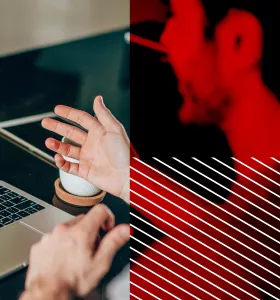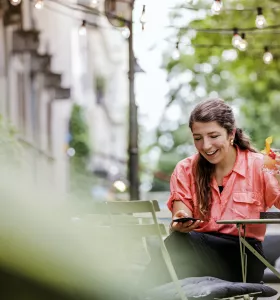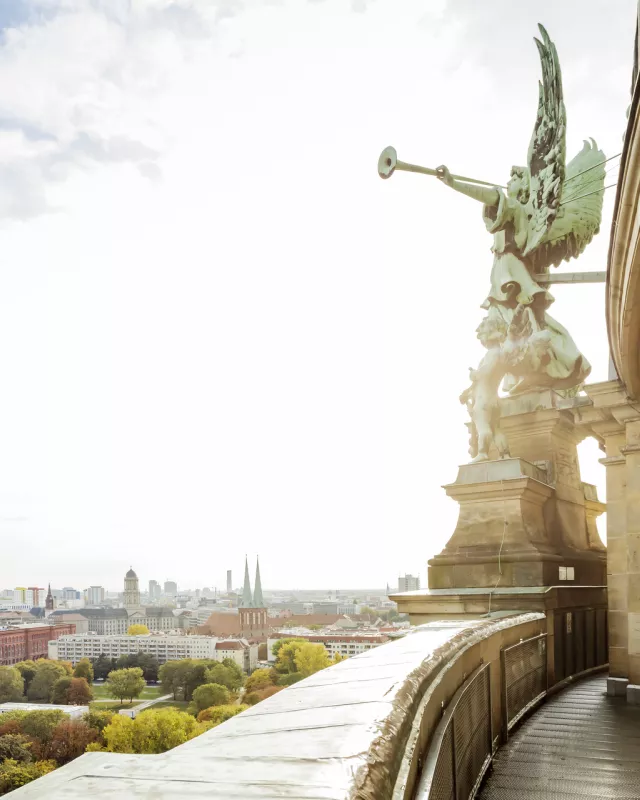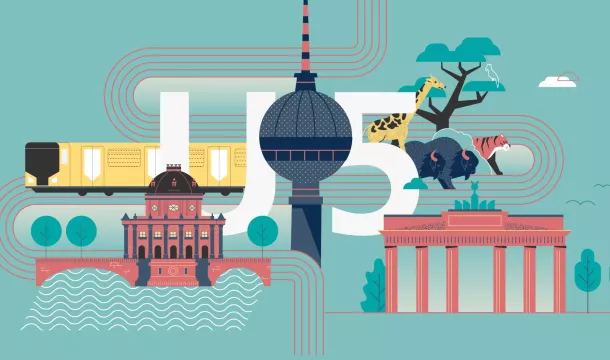Only connect: Explore Berlin with the new U5 metro line
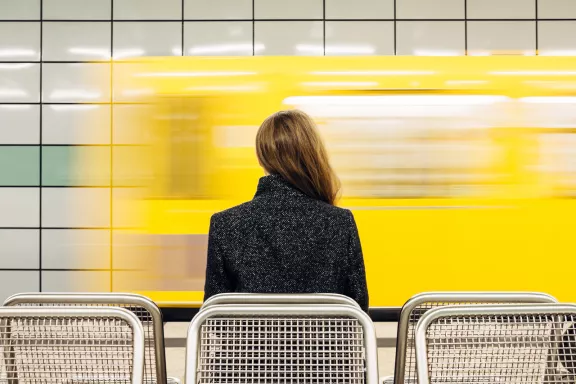
Berlin, June 2021 The extended U5 metro line went into operation in December 2020. A tunnel just over two kilometres long now closes the previous gap between the Brandenburg Gate and Alexanderplatz. For locals and visitors alike, this stretch of the U5 provides a direct link from the city centre towards the east of the city. In just 41 minutes, you can travel from Berlin’s Central Station to the Hönow district without changing trains.
But the U5 extension brings other benefits as well, including three new metro stations at the City Hall, Museum Island, and the Unter den Linden boulevard right in the heart of the city. With the new extended line going into operation, these three stations – Rotes Rathaus, Museumsinsel and Unter den Linden – will be opened successively. The stations Rotes Rathaus and Unter den Linden were opened first, to be followed by the station Museumsinsel on 9 July 2021. For Berlin’s visitors, this is especially practical as all three are close to many main sights – including the Nikolaiviertel (Nikolai Quarter), the Berliner Dom (Berlin Cathedral) and the city’s renowned Staatsoper opera house. The new U5 extension not only makes sightseeing even easier, but also lets you leave the usual tourist trails and discover the hidden gems along this metro line. In full operation, the U5 serves 26 stations along a total route of 22 km.
The new stations and their environs
Rotes Rathaus station
Rotes Rathaus – Elegance in black and white
The new Rotes Rathaus metro station is directly in front of the Berlin City Hall in the Mitte district. The station, planned by Berlin-based Collignon Architects Office, has two levels and three exits. Its modern design, clearly structured in white and black, was inspired by the medieval town hall’s historic ceiling vault discovered during archaeological excavations. In a contemporary analogy to the Gothic vault’s pillars, the architects have set funnel-shaped capitals on the supporting columns. In combination with the side platforms, the lines of these spreading flat forms, reminiscent of some types of mushrooms, enhance the sense of space. The result is an especially open and large station hall which, with the hand-cut terrazzo tiles, looks extremely elegant.

The vicinity of the Rotes Rathaus station has many sights, museums, and attractions to discover. Near the City Hall, for example, Berlin’s TV Tower soars an impressive 368 metres up into the sky. The viewing platform of this popular tourist magnet offers stunning 360° panoramic views out across the city. Marienkirche (Saint Mary’s Church) and the Neptunbrunnen (Neptune Fountain) are set on the square between the TV Tower and the City Hall.The Neptune Fountain is one of Berlin’s largest fountains, while Saint Mary’s is the city’s oldest parish church still used for services today. Just a few minutes’ walk takes you to Alexanderplatz square, named in 1805 after the Russian Tsar Alexander I. This busy square is crossed everyday by tens of thousands of people. Many are leaving, changing, or catching trains while others are drawn to one of the attractive shopping centres in the vicinity, heading for one of the nearby hotels, or just enjoying a stroll across the eight hectares of this large pedestrian zone. Incidentally, the most popular meeting place on Alexanderplatz is the renowned Weltzeituhr (World Clock). Now a heritage monument, the clock is ten metres high and decorated with the names of 146 different locations around the world.
In contrast, just south of the Rotes Rathaus, you can find a vastly different world in the Nikolaiviertel (Nikolai Quarter), today a modern, historic-style reconstruction of the original area. Around the reconstructed Nikolaikirche (St Nicholas’ Church), you can stroll small medieval-style streets and enjoy this picturesque setting with its historic patrician houses, small shops, and cosy restaurants.
Similarly, just a short walk from the Rotes Rathaus station you can also find one of Berlin’s most popular museums – the DDR Museum with its fascinating hands-on look at everyday life in the years of East Germany.
Museumsinsel station
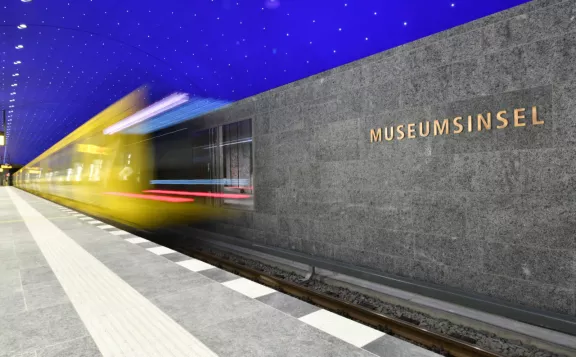
Museum Island – Under a starry sky
The Museumsinsel station, designed by the renowned Max Dudler architectural office, is scheduled to open on 9 July 2021. Around 180 metres long, the station is set to the south of the Schlossbrücke bridge and partially constructed underneath the Spree Canal. The station vault’s ultramarine ceiling contains over 6600 spots of lights transforming it into a glittering night sky. This special feature was inspired by Friedrich Schinkel’s legendary stage setting for a performance of Mozart’s Magic Flute in Berlin in 1816.
Since 1999, the Museuminsel (Museum Island) has been inscribed as UNESCO World Heritage. Comprising a total of five museums, this is not only one of Berlin’s leading sights but also one of its most varied. With so much to see, visitBerlin’s Berlin WelcomeCard Museum Island offers a practical solution to exploring the thousands of years of art and cultural history on show here. On three consecutive days, card holders enjoy free admission once a day to each museum –– the Altes Museum, Neues Museum, Alte Nationalgalerie, Bode Museum and the Pergamon Museum. Designed by Alfred Messel, the Pergamonmuseum (Pergamon Museum) is one of Berlin’s most visited sights. Its three wings house the impressive Collection of Classical Antiquities, the Museum of the Ancient Near East and the Museum of Islamic Art. Due to refurbishment, individual sections of the museum are presently closed, including the north wing with the Pergamon Altar. The renovation is scheduled to be completed in 2024.
The Bode Museum is not only home to a world-renowned Sculpture Collection and over 100 Old Masters from the Gemäldegalerie, but also the Museum of Byzantine Art and much of the Numismatic Collection. The Neues Museum (New Museum) showcases a selection of masterpieces from the collections of the Egyptian Museum and Papyrus Collection, the Museum of Prehistory and Early History, and sculptures from the Collection of Classical Antiquities. The Alte Nationalgalerie (Old National Gallery) at the heart of the Museum Island presents sculptures and world-famous paintings, including works by Caspar David Friedrich, Claude Monet, and Auguste Renoir.The Altes Museum (Old Museum) also shows many of the masterworks of classical antiquity from the collections of the Staatliche Museen zu Berlin (National Museums in Berlin). The James-Simon-Galerie (James Simon Gallery) is the Museum Island ensemble’s modern central entrance. Designed by British architect David Chipperfield, it also provides space for temporary exhibitions as well as an auditorium and a café.
The Altes Museum borders on the Berliner Dom (Berlin Cathedral)and the Lustgarten park. Originally, fruit and herbs were grown on today’s Lustgarten site before it was first landscaped as a ‘pleasure garden’ in the early seventeenth century. Down the centuries, this little park has often been redesigned. Today, its large green lawns offer many visitors an ideal place for a welcome break when sightseeing. The Berliner Dom is the largest church in modern Berlin. The main nave with the massive dome soaring above it is certainly one of the church’s signature sights, but the building also houses the simpler Baptismal and Matrimonial Chapel as well as the Church Museum. Here too, you can find the Hohenzollern Crypt, one of the most important dynastic sepulchres in Germany, containing nearly 100 sarcophagi from five centuries. The Crypt is presently being refurbished and scheduled to reopen in 2023 at the earliest. This impressive church offers guided tours as well as the chance to enjoy stunning views of the city’s skyline from the dome, around 270 steps up!
The Humboldt Forum, a new venue forging a link between art, culture, and science, is set opposite the Museum Island. The façade is partly a reconstruction of the former baroque city palace. Due to corona restrictions, the opening year begins in mid-December with a virtual tour of the building. From 2021, the Humboldt Forum, the planned exhibitions and the collections of the Ethnological Collections and the Asian Art Museum will be open to the public.
Unter den Linden station
Unter den Linden – A science station
This new station, stretching almost to Charlottenstrasse from the west of Friedrichstrasse, is not only named after the famous Unter den Linen boulevard, but also directly underneath it. On the central tree-lined reservation, there are three entrances/exits – west and east of Friedrichstrasse, as well as west of Charlottenstrasse. The station also has two other entrances/exits in Friedrichstrasse to the north of Behrenstrasse. The long underground construction phase did not leave this magnificent boulevard always looking its best. Now, in keeping with its name – Unter den Linden literally means ‘under the linden trees’ – 110 new trees are to be planted along the boulevard by 2021.
With its three levels, the Unter den Linden interchange metro station was designed by the Hentschel and Oestreich architectural office, which also planned the Brandenburg Gate station. Here, they took a similar approach to both the design and materials, from walls lined with shell limestone to floors tiled in white terrazzo, with the added feature of elegant black columns in the station hall itself. Here too, the rear track walls will be used to present an exhibition. In this case, the neighbouring HU Berlin University is the host – so no wonder this metro stop is already known as the ‘science station’. The exhibition explores the topic of the Anthropocene, the geological period where human activity has shaped the Earth.
The Unter den Linden boulevard runs from Brandenburg Gate to Schlossbrücke bridge, close to today’s heritage site of the Friedrichswerdersche Kirche. Commissioned by Prussia’s Crown Prince Friedrich Wilhelm, the church was designed in a neo-Gothic style by Karl Friedrich Schinkel and built from 1824 to 1831. The Staatliche Museen zu Berlin (National Museums in Berlin) now uses the former church building as an exhibition space for a selection of sculptures from the Alte Nationalgalerie collection.
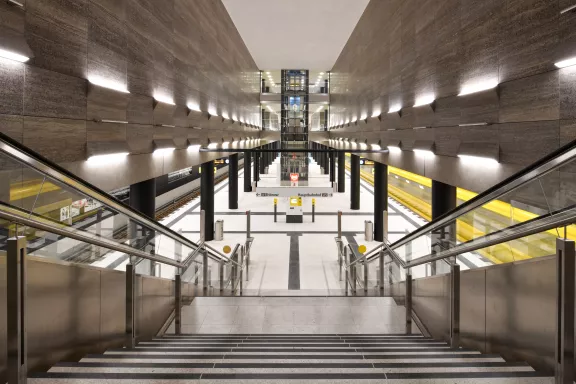
Along Unter den Linden, you can also find a wealth of other fascinating places to visit – for example, the Humboldt-Universität zu Berlin (HU Berlin university), founded by Prussian King Friedrich Wilhelm III in summer 1809. As Berlin’s largest and oldest university, it was renamed in 1949 after the renowned Prussian scholars and researchers Wilhelm and Alexander von Humboldt. The nearby neo-classical Staatsoper Unter den Linden opera is also well worth a visit. The opera house was designed by architect Georg Wenzeslaus von Knobelsdorff at the order of Friedrich the Great, and built from 1741 to 1743. Destroyed in the Second World War, the opera house was reconstructed in the post-war years as part of the Forum Fridericianum. Further along the boulevard, the Neue Wache (New Guardhouse), a memorial site to the victims of war and tyranny, invites visitors to stop, rest and reflect. The Zeughaus (Arsenal) is one of Berlin’s most important baroque buildings and the oldest building on the Unten den Linden boulevard. Today, it houses the German Historical Museum (DHM) with its exhibition offering a fascinating insight into 1500 years of German history.
After so many museums and so much culture, your thoughts might turn to some light refreshments or lighter entertainment. You can find all that and more as you stroll towards Brandenburg Gate – stopping off, for instance, to visit celebrities and stars galore in the Madame Tussauds wax museum, enjoy five-star luxury at the legendary Hotel AdlonKempinski, or indulge in Austrian specialities in Café Einstein. At Brandenburg Gate, take your time to view Berlin’s most iconic sight. The city’s only surviving historical city gate, it came to symbolise Berlin’s Cold War division into East and West – and, since the fall of the Wall, stands for a reunified Germany. The sandstone Brandenburg Gate also represents one of the earliest and most attractive examples of neo-classical architecture in Germany.
Hidden gems on the new section of the U5 metro line

Aside from the well-known sights in the city centre, there are many exiting things to discover near other stations along the U5 line. For example, if you leave the train at the Kienberg Station, make sure you plan in a visit to the nearby park. Here on a spreading 60 hectares, you can enjoy a relaxing stroll down the Kienberg Promenade past magnificent meadow landscapes. The park’s highlight is the cabin cable car taking visitors to the summit of Kienberg hill, 110 metres up. On the hill, the Wolkenhain viewing platform has amazing views out across the city. Afterwards, don’t miss the nature bobsleigh run! As you bobsleigh back to the valley, enjoy all the action on the 500-metre track travelling at speeds up to 40 kmph. Down the hill again, the bobsleighs make two full loops at eight metres up before joining the conveyor belt taking them back up the hill. From the Kienberg hill, you can also move on to the Gärten der Welt (Gardens of the World). Often rated as Berlin’s most idyllic gardens, the 43-hectare site takes visitors on a world trip through ten themed gardens, including Bali, Japan, Korea and Europe. Young visitors also have a choice of fun things to do, from a maze and a hedge labyrinth to a variety of playgrounds.
Just three stops further on the U5 takes you to Elsterwerdaer Platz station, ideally located for a visit to Schloss Biesdorf (Biesdorf Palace). Set in beautiful park grounds of around 15 hectares, this neo-classical palatial stately home is also a communal gallery space for the Marzahn-Hellersdorf district and hosts changing exhibitions of contemporary art. With spreading lawns, serpentine paths and a valuable old stock of trees, the palace park and grounds are open to the public. This popular recreational area is also home to the Biesdorfer Parkbühne open-air stage with its summer programme of concerts, films, and other events.
A few stations further down the line, you arrive at the Lichtenberg district. If you leave the train at the Magdalenenstrasse station, you are close to the nearby Stasi Museum. The museum’s exhibition tells you all about the GDR’s Ministry for State Security (Stasi) and the impact of its activities on people in East Germany. The Theater an der Parkaue, a quite different venue in the vicinity, is one of Germany’s largest children and youth theatres. Since the theatre opened in 1950, it has presented over 35 shows on a total of three stages. These imaginative and inspiring shows are aimed at children and school classes of different ages, but are also great entertainment for families and interested visitors.
Animal fans will be heading for the Tierpark station to visit Europe’s largest wildlife park. The Tierpark Berlin zoo, opened in 1955 and covering 160 hectares, is home to over 7979 animals from 656 different species. After extensive refurbishment, the Alfred Brehm House and Tropical Hall was reopened in summer 2020. With its fascinating rainforest landscape and such exotic animals as the Sumatran tigers and Malayan sun bears, it transports visitors to distant south-East Asia. By late 2022, the Tierpark is also planning to complete the most modern elephant enclosure in Europe.But the Tierpark also holds a hidden gem for culture fans too – the neo-classical Schloss Friedrichsfelde manor house at the heart of the wildlife park. The first house on the site was built in 1685 as a summer residence for the Naval General-Director of the Electorate of Brandenburg. Down the centuries, the house had a chequered history under various owners – including Prince Ferdinand of Prussia, the Dukes of Courland, Catharina von Holstein-Beck, and the von Treskow family. Ultimately, a new era dawned in 1954 when the grounds, originally designed by renowned landscape architect Peter Joseph Lenné, were taken as the starting point for the wildlife park. Today, Schloss Friedrichsfelde is a popular place to visit and a venue for exhibition and events.
If you are travelling into the city centre, the U5 takes you to the Frankfurter Tor, Weberwiese and Strausberger Platz stations – all on the broad boulevard of Karl-Marx-Allee. In 1952, this ‘grand GDR boulevard’, then called Stalinallee, became the site of East Berlin’s first large-scale socialist prestige building project. The prototype apartment house was the ‘Hochhaus an der Weberwiese’ tower block completed in 1951-52. The work of Hermann Henselmann, chief architect of the Stalinallee project, it provided a model for the new tower blocks with their well-equipped interiors and decorative façades. In 1961, the boulevard was renamed Karl-Marx-Allee. By the time, the second construction phase was launched between Strausberger Platz and Alexanderplatz, building policy had undergone a paradigm shift. The architecture of such cultural amenities as Café Moskau and the two cinemas, the Kino Kosmos and the Kino International, was informed by a symmetrical, functional style. Today, the boulevard is listed as a heritage site.
The area around the Weberwiese station offers two venues where you can either immerse yourself in the world of computer games or relax with a who-done-it. In the Computerspielemuseum, Berlin’s museum of computer games, enjoy an interactive trip through the cultural history of gaming. Here, the world’s largest collection from 60 years of computer games offers everything from functioning classic games to 3-D simulators, and includes such rarities as the GDR’s Poly-Play arcade game as well as the Nimrod, the world’s first gaming computer. Just three minutes’ walk away, the converted substation Umspannwerk Ost has been transformed into an arts venue housing the Berliner Kriminaltheater – and with its programme of classic murder mysteries, you can be sure of a thrilling evening’s entertainment!
More information:visitBerlin.de/en/u5-berlins-new-metro-line
The text can be used in extracts or edited. Please indicate the copyright visitBerlin. Please forward sample copy to: presse[at]visitBerlin.de or visitBerlin | Pressestelle | Am Karlsbad 11 | D-10785 Berlin.
Infographics: the new metro line
Download the infographics here for free.

